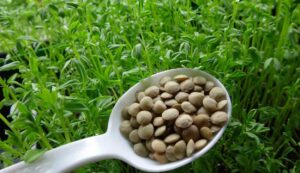Lentil Crop Cultivation: Farmers should do this management while sowing lentil crop
Lentil Crop Cultivation: Among pulse crops, farmers grow lentils on a huge scale during the Rabi season. The lentil crop provides farmers with high yield at minimal cost. The lentil crop is unique in that it needs very little watering. When lentils are sown at the proper time, they may yield up to 25 quintals per hectare in 110–140 days. In addition, the lentil crop yields around 30 to 35 quintals of animal feed; nevertheless, the wilt disease severely damages the crop. In this case, controlling the wilt disease at the time of lentil crop seeding is crucial.

According to Dr. NP Gupta, Krishi Vigyan Kendra Niyamatpur’s Agricultural Expert, wilt disease in lentil crops is a dangerous condition that damages the plant’s roots. A particular kind of fungus that grows in soil is the source of this illness. By infecting the plant’s roots, this fungus prevents the plant from absorbing nutrients and water. The plants progressively dry out and wither as a result of this illness. The plant’s lowest leaves first turn yellow. The inside of the plant becomes brown when the stem or root is severed. The plant dries out and withers over time.
After treating the seeds, plant them.
It is crucial to treat the seeds in order to protect the crop against this disease. Only when the seeds have been treated can the lentil crop be planted. Three grams of Thiram per kilogram of seeds should be used to cure them. In addition, treat with any systematic pesticide.
Additionally, soil remediation is crucial.
For a lentil crop to be healthy, soil management is also crucial. because fungus is the cause of this sickness. In this case, when the field has been deeply ploughed, combine Trichoderma with cow dung manure and distribute it out. Then, use a patta to level the ground and plant lentils.
Eliminate the contaminated plants.
Should wilt disease signs appear in the lentil crop after it has been sown, remove the diseased plant from the field and kill it. By doing this, the disease’s spread will be limited and the remaining crop will be protected.
Make use of Rhizobium
Rhizobium should also be used by farmers to increase the yield of their lentil crop. A particular kind of bacterium called Rhizobium produces nodules in the roots of legume crops. These nodules extract nitrogen from the atmosphere and prepare it for absorption by the plant. Since nitrogen is essential to plant growth and development, it is a particularly vital nutrient for plants. Farmers won’t need to add nitrogen separately after employing Rhizobium.
Apply a systemic pesticide.
Farmers should apply systemic insecticides to the lentil crop to prevent disease and to achieve high yields. By doing this, the lentil crop is protected against illnesses and, in the event that they do occur, the crop is not severely harmed.

